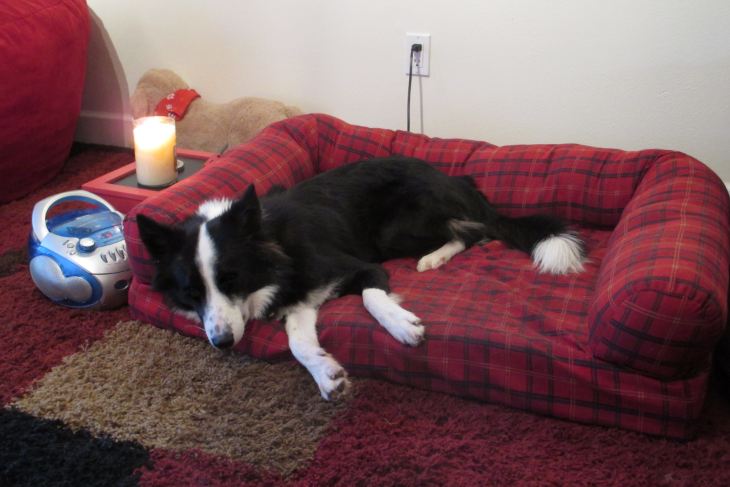(This post was written for dog owners with a high energy and/or a destructive dog)
Here’s Finn again. In addition to his food guarding and many other issues, he also came with over-the-top-off-the-wall energy. On a scale of 1-10 I rated him above 20.
It’s not your typical focused Border Collie high energy. It was mixed with anxieties and fears and he didn’t have an outlet for it. First 6 weeks or so, he never lay down unless he was in his crate at night. When he lay down, he never put his chin down or flopped to his side. He was over stimulated and never stopped moving. In the crate, he whined, barked, scratched, and tried to eat anything he could access. Because of his guarding issue, he couldn’t have bones and chews in his crate until it was under control. On the 6th weekend, he took his first short nap after 10 hours of mental and physical exercises.
4.5 months later, his energy level went down to around 7 and he is much more focused and relaxed. I love high energy dogs but I have to have my Zen time when I’m in the house. Even my high energy lab learned when it was time to chill at an early age. When I got my first Border Collie Jazzy, I promised to her that I’d dedicate at least 2 hours training or exercising her, if not more. And I kept that promise until she got much older. I also made sure there was one day dedicated for “do nothing day”. It prepared her for days when I was sick, on a trip or even for post-surgery days. Finn, on the other hand, probably never had any of that before he came to m. No structure, no outlet, no training.
There are many things I did with Finn to install an off switch. One thing that helped was making him obsessed with interactive and structured play outside. Just as potty training, I wanted him to associate outside for activities. When he was loose in the house, all toys were picked up and there was very little talking and interacting. Talking to him, looking at him or touching him got his arousal level up in a split second. (He also peed when he was aroused) Treating by hand made him too excited. Massaging, treating or talking weren’t options for him in the beginning. I had several crates, pens and gates set up to prevent him from running and zooming in the house.
Scent, sound, taste and sight
I wanted to experiment with operant conditioning, with a touch of classical conditioning. (They usually intertwine anyway) My goal was for him to associate some of my daily routine with “settle” just as my dogs did. I didn’t want to rely it all on physical and mental exercises. Border Collies are notorious for being obsessive with routines but we can use that to our advantages too. When I get on my computer, my dogs lie down by my feet. When I watch TV, they jump up on the couch. When I put on a jacket, they run outside waiting, unless I have heels on. Jazzy waits for me at the front door when I start pulling a trash bag out of the bin, and both run to the cookie jar after we get a pizza delivery. They learned the patterns through repetitions. I decided to teach Finn when it was time to switch-off. First several weeks were tough. He had to go through “detoxing” in his crate and pen. Once he learned that whining and barking got him nothing, he finally gave up.
For scent, I used a special candle I light when I want to relax. I could have used lavender spray or calming drop but I wanted to be able to turn it on/off by putting a lid on the jar. It is similar to smelling the ginger bred cookies in December and having the warm and fuzzy feeling inside. If our nose can make that kind of classical association, dogs should be able to do that easily. For sound, I used turning on the TV because that’s what most people do and expect the dogs to settle down.
I have tried “Dog’s ear” music. There was an interesting blog post about this particular music by Dr. Patricia McConnell earlier this month. I did a quick experiment on this music with my fosters in the past but I did not find significant changes. Perhaps I didn’t spend enough time on it. But I’ve noticed that it made a huge impact on me. It is very soothing and it helps ME to fall asleep. And I’ve always found piano music to be relaxing. I can see that my dogs are learning to settle when they hear this music because of my reaction to the music. I am leaning more towards the idea of my behaviors affecting them rather than music having a direct impact.
For taste, I used a stuffed kong in the beginning. (Once his guarding issue was under control) If I’m the one tossing treats he gets too excited. I removed the food from the exercise as soon as he associated the other cues with settle. Visual cues were the TV, his bed, me being on the iPad on the couch, and the candle etc. Early on I used confinement, but removed it once he learned to stay on the bed. I switched it to him being on a loose leash, then no leash at all. Before doing these exercises, he learned “Bed” “Down” “Wait” “Kennel” cues reliably but I never gave verbal cues during “settle” exercise. I wanted it to be his choice. I just set it up so that it is easier for him to offer these behaviors.
In the video, you will see the steps I used to introduce the off-switch cues while removing the aids (food, barrier) gradually. You will also see my Border Collie on the right, who used to go “nuts” whenever I exercised. Two birds with one stone…there I have two calm Border Collies while I get myself in shape.
~~~~~~~~~~~~~~~~~~~~~~~~~~~~~~~~~~~~~~~~~~~~~~~~~~~~~~~~~
This month has been tough for dog owners in Texas. Rain rain rain…nasty yard and lots of winds. Unlike people in the North, we are not as brave when it comes to cold weather. So I started teaching him tricks to stimulate his mind. Furniture agility is so easy to teach and you don’t need a whole a lot of space to do.




So clever of you to use a whole set of environmental cues for relaxation.Thanks for sharing your method. I so need to do this! The only time my dogs know not to bother me is when I’m eating. I haven’t been consistent in any other situation to let them know that it is time to chill. You’ve given me some good ideas.
Funny in a way how a troubled foster forces me to come up with solutions. Until him, our house was not as structured, less rules. If you didn’t have to come up with one, your house probably have good Zen already :)
With four dogs, I’ve got good Zen here, if I do say so myself. What I don’t have is settle. And it’s not only my high arousal dog who needs it, although she is kind of the last straw. But I also have gradually reinforced my most low energy dog for bothering me over the years. She is soft but very persistent. What a good training job I did on that one!
Ha! Been there too!
It’s interesting how many of these associations I’ve set up completely by accident. Everything from violin music to baking smells (I bake when I’m grumpy) to using the laptop instead of the desktop–my dogs have learned these signals, and never bother me after these cues. It also explains why my Border Collie was so exasperated when I was learning how to knit. None of the off-switch cues were present, so she couldn’t understand why I wanted her to leave me alone. Even my body language was wrong for down time. Definitely a training mistake I’ll try not to repeat.
Furniture agility looks amazing–I’ll have to remember it next time I have a young, high-energy dog. Thanks for all the training ideas!
I cook (can’t bake too well) when I’m grumpy too! I’ve noticed that too about BCs trying to figure out how to react to new stimulus. (like with your knitting) When I started Zumba on Wii, she decided it was time to stare at my feet, then whine and run around!